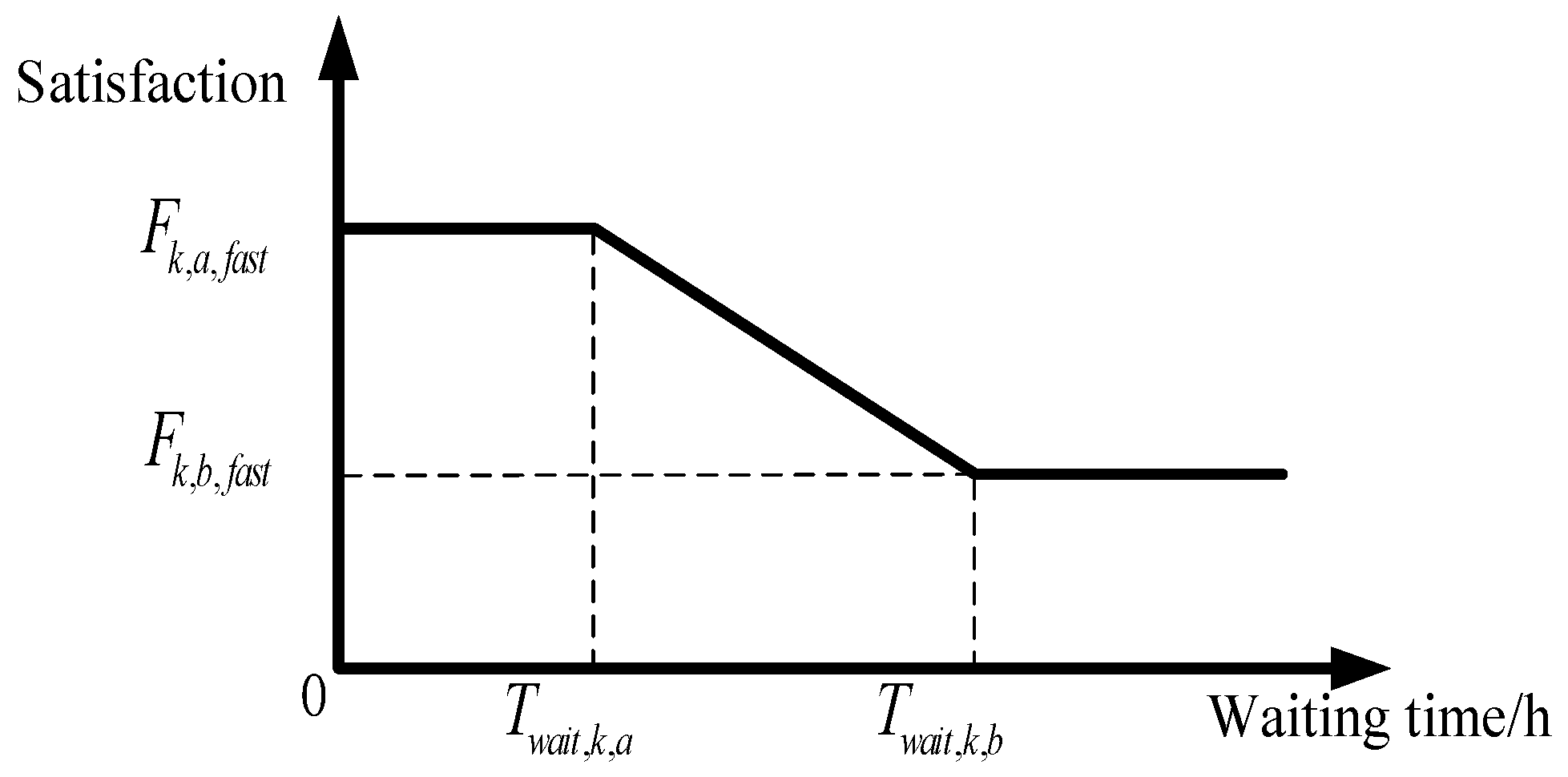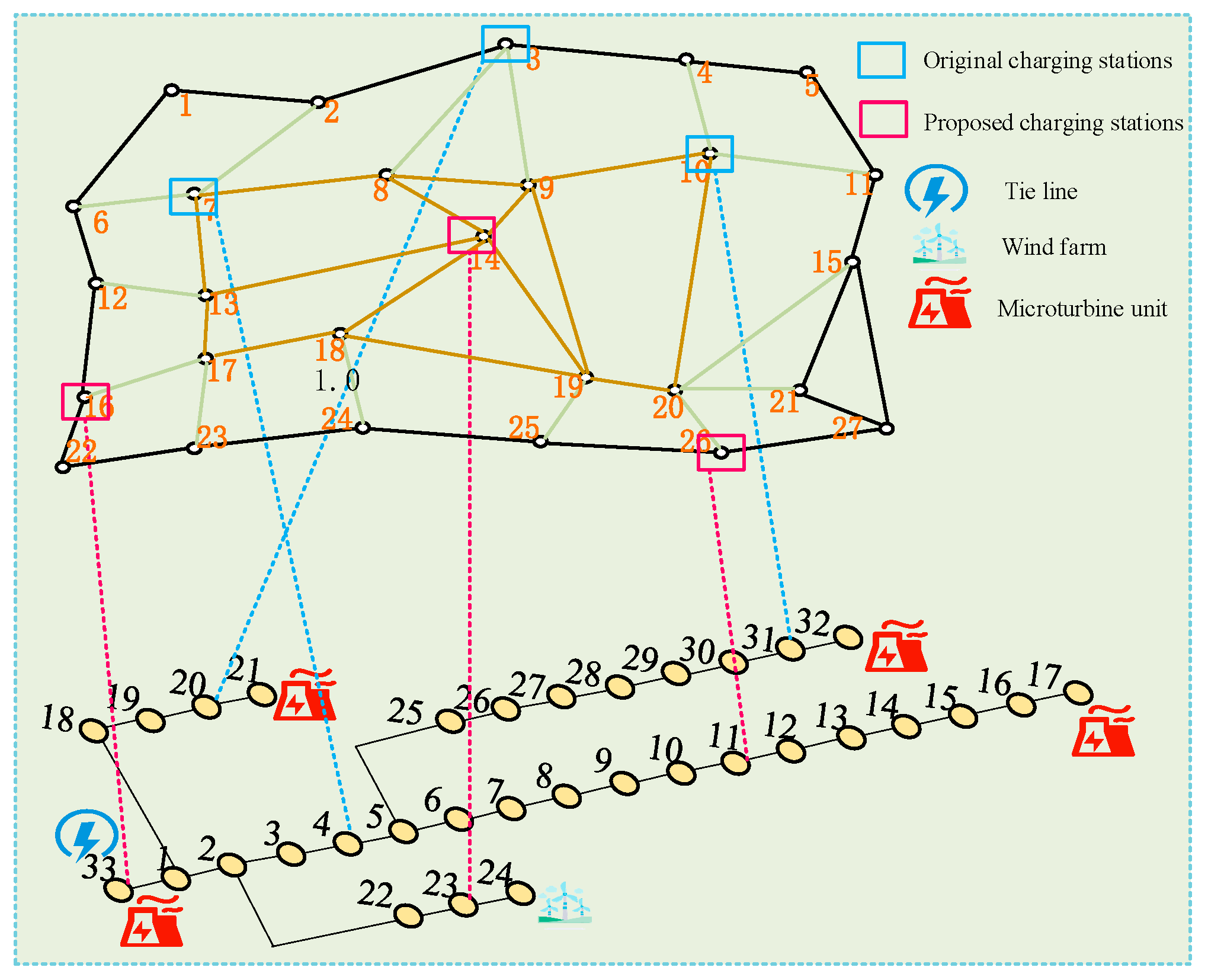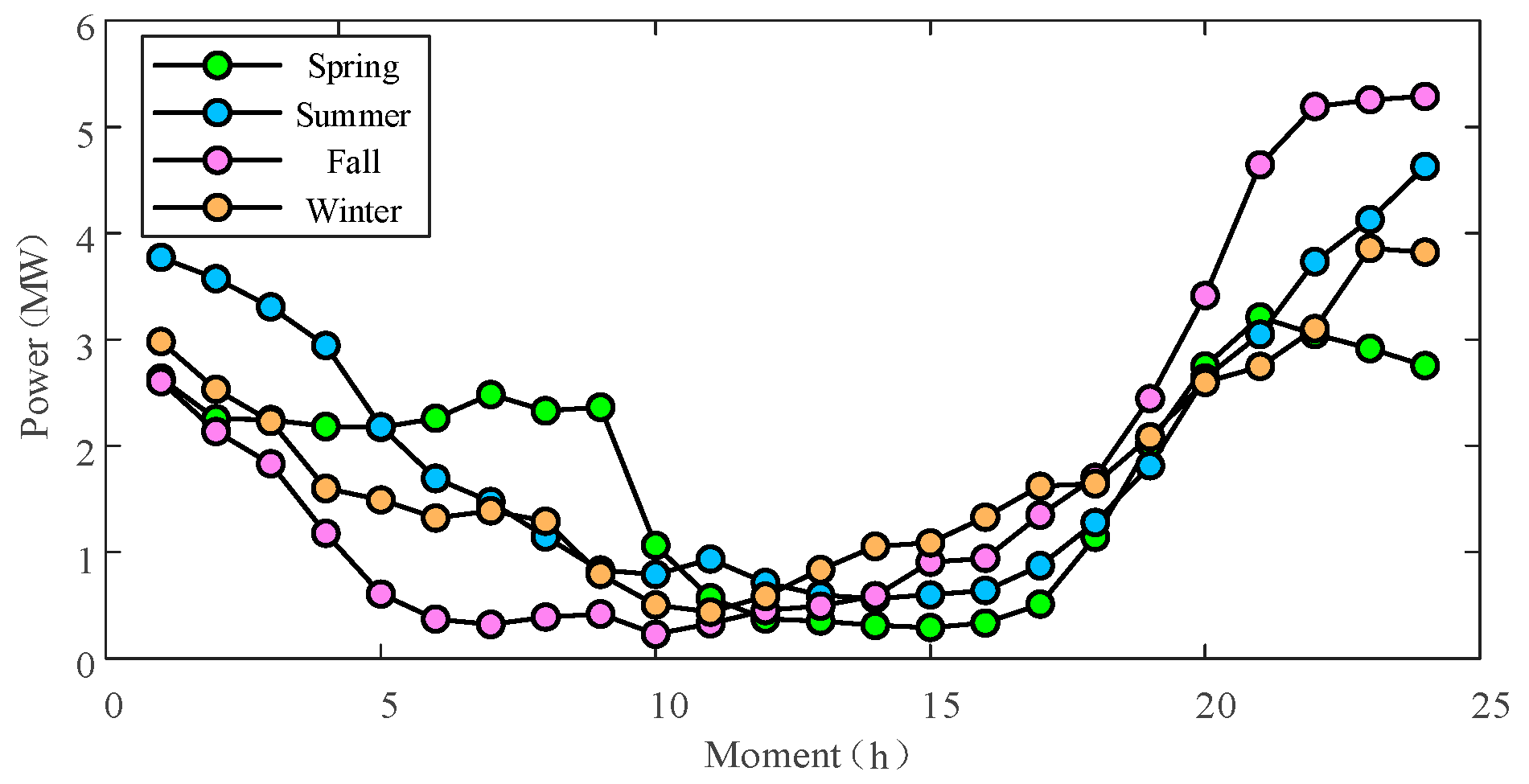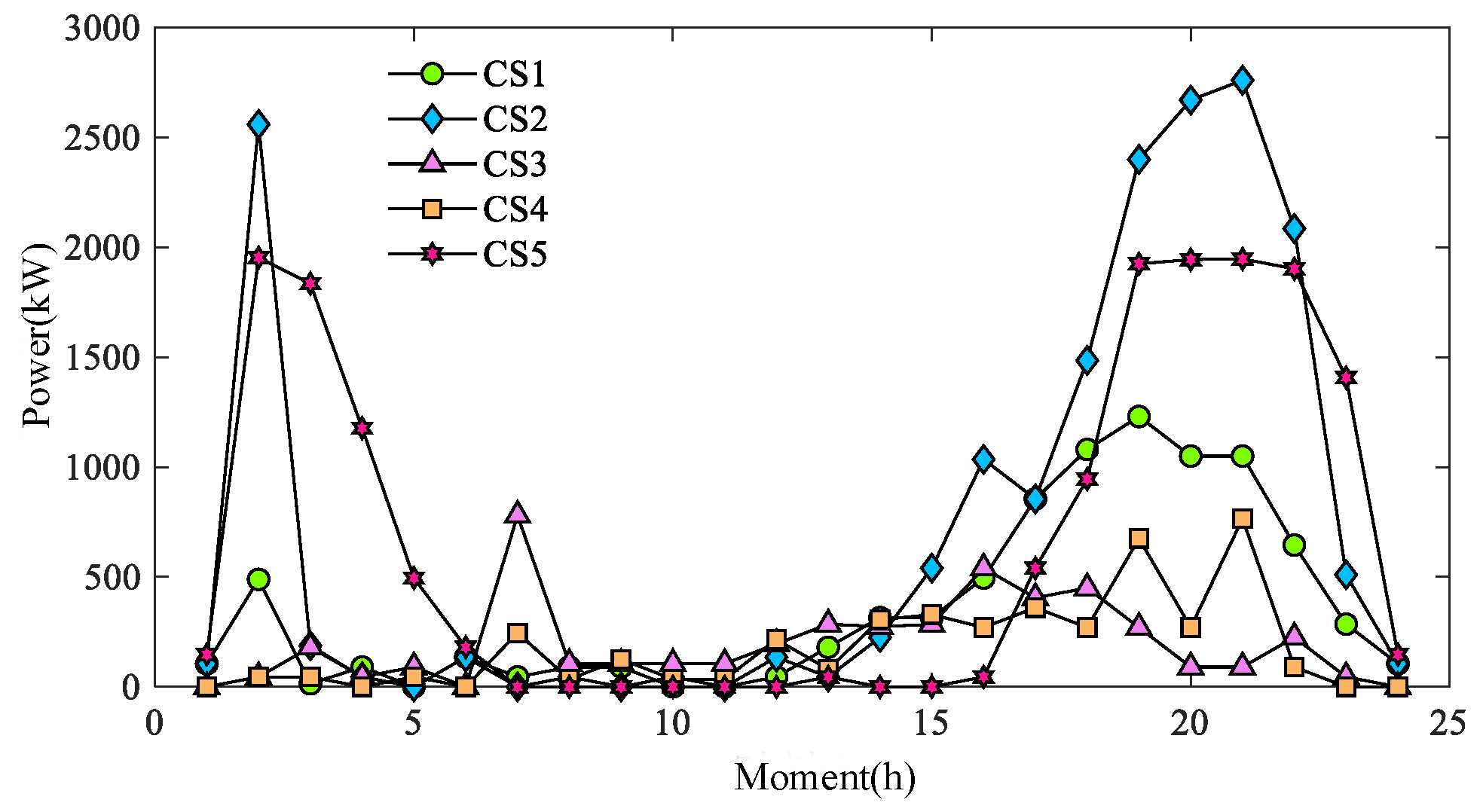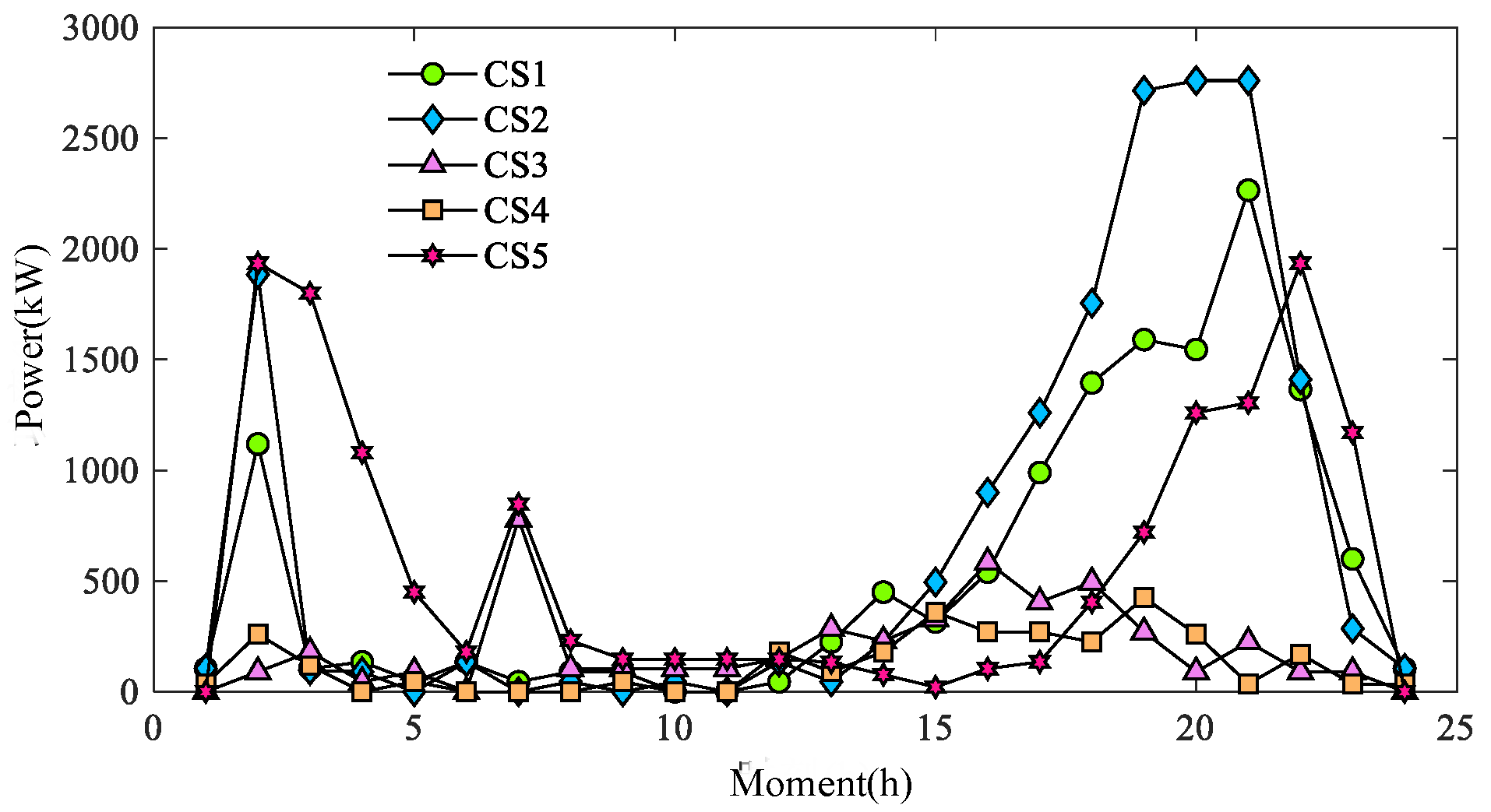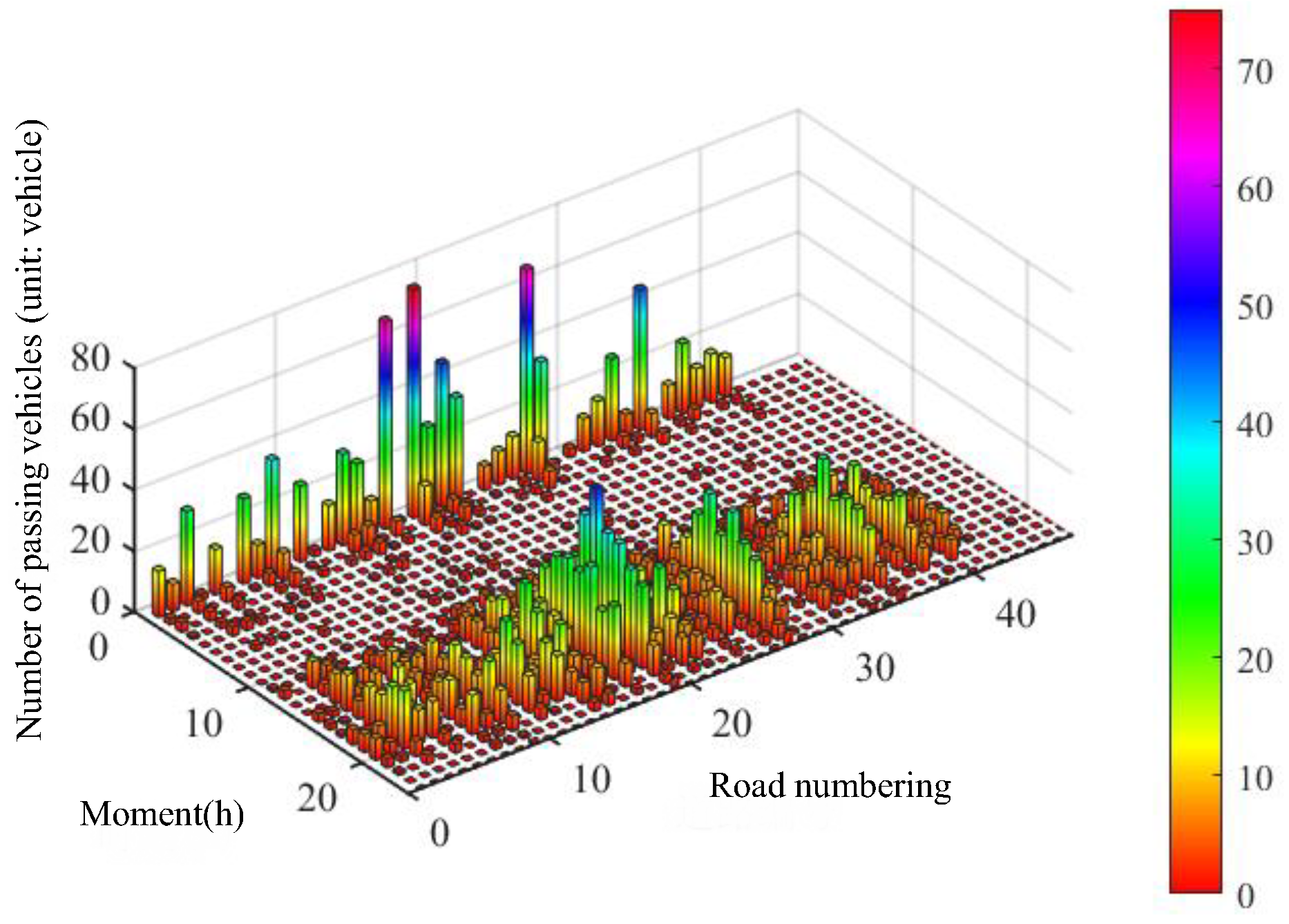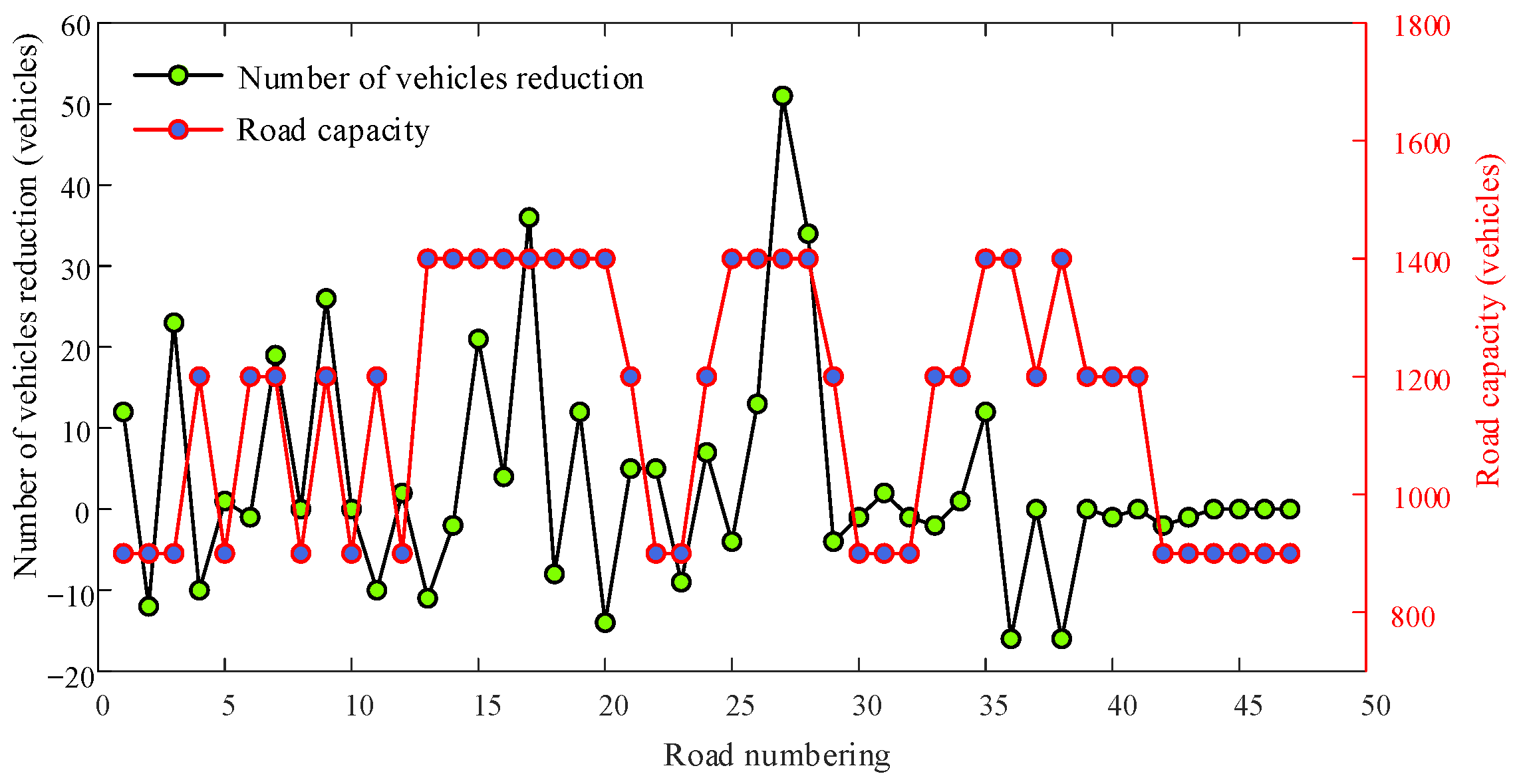1. Introduction
With the rapid advancement of the EV industry, the ownership of EVs and their charging power have increased significantly, gradually exerting a greater impact on the power grid, making it urgent to address the evolving demands of diverse users. EVs usually provide users with two options: fast charging and slow charging. Fast charging is convenient for users to continue driving, but it will cause a certain loss to the battery. Slow charging can extend the battery life. At the same time, fast- and slow-charging devices have different prices and impacts on the power grid [
1].
An EV charging station is an important unit of the electric transportation coupling network, and its construction location and charging pile configuration will have an impact on the operation of the electric transportation coupling network. The CS location, capacity, and fast- and slow-pile ratio will affect the distribution of the surrounding traffic flow. How to make the planning scheme of CSs to meet the needs of different users for fast- and slow-charging piles, and optimize the operation of the power traffic coupling network while improving the user’s charging satisfaction [
2,
3] has become an urgent need to carry out research nowadays.
A fast-charging station planning model considering traffic and power constraints was proposed, with objectives including CS investment cost, distribution line cost, and substation expansion cost [
4]; a fast CS location and capacity optimization model for EVs was established, aiming to maximize user-captured traffic flow and minimize investment cost [
5]; dynamic traffic demand and user-balanced double-tier CS and DC fast-charging piles were considered in the highway network planning model, which also takes into account the operating cost of the distribution network under the cooperative operation of the transportation network (TN) and the electric network (EN) [
6]; a traffic distribution model was established to optimize the location and capacity of CSs, considering the dynamic traffic flow of fuel vehicles and EVs [
7]. All of the above studies are aimed at the operation and planning costs of the coupled electric transportation network, ignoring the needs of EV users for different types of CSs, and failing to realize the improvement of user satisfaction.
Several scholars have carried out studies examining the relationship between user charging convenience and their overall satisfaction with charging services. A fast CS scheme planning model based on stochastic user equilibrium has been established to address the congestion issue of CSs serving EV charging demands at the district and county levels [
8]. To ensure the reliability of grid operation while improving charging convenience—with consideration given to the impact of EV charging demand uncertainty on the grid—a CS location planning model based on graph computation has been proposed [
9]. A two-tier joint planning model, which relies on the coupling of traffic–electricity equilibrium between fast CSs and distribution grids, has been developed [
10]. Similarly, another two-tier joint planning model for EV fast CSs and distribution networks, also grounded in traffic–electricity equilibrium coupling, has been established; this model specifically focuses on planning the number of charging piles and queuing spaces at fast CSs, with the objective of maximizing the benefits of both fast CS operators and users [
11]. A CS planning strategy adaptive to EV penetration levels has been formulated, which ensures the quality of fast-charging services under the premise of joint planning for EN [
12]. Based on the forecast of EV fast-charging demand distribution in urban areas, a CS siting and capacity model that considers the interests of CS operators, EV users, and the power grid has been built; this model takes the number of chargers at CSs, the distance between CSs and fast-charging demand points, and the distance between individual CSs as constraints [
13]. For electric taxi CSs, two planning methods based on GPS trajectory mining have been proposed: one optimizes the number of charging spaces for electric taxis, while the other aims to optimize three key factors—the construction and operation costs of CSs, the arrival time cost of electric taxis, and the charging waiting time [
14].
Most of the above studies focus on the location and capacity of fast CSs to optimize grid operation costs and user satisfaction. However, they ignore the preference of users for fast- and slow-charging piles in different schemes, and existing studies often fail to fully account for the actual needs of different user groups. Optimizing the ratio of fast- and slow-charging piles in CSs not only reduces the power of CSs and the impact on the grid current but also meets the needs of more users.
In view of this, this paper investigates a collaborative planning model of multi-type CSs considering comprehensive user satisfaction. In this paper, “multi-type” primarily refers to two categories: fast-charging stations and slow-charging stations. However, aligned with the behavioral characteristics of different users, the definition of “multi-type charging stations” in this study is specified as integrated charging service facilities equipped with both fast-charging piles and slow-charging piles, which can meet the differentiated needs of various EV users. Specifically, fast-charging piles are mainly targeted at fast-charging users with high-frequency usage demands and high sensitivity to charging time, such as taxi operators. In contrast, slow-charging piles are designed for slow-charging users whose primary needs are commuting and daily travel—such as private car owners—who pay more attention to charging costs and convenience. The quantity, configuration, operational status, and resource occupancy of different types of charging piles directly affect users’ comprehensive charging costs and charging satisfaction. In turn, this further determines the spatiotemporal distribution characteristics of the overall charging load.
Building on this framework, the proposed methodology further establishes a comprehensive linkage between user behavior, charging load, and user satisfaction. Fast-charging user satisfaction is associated with queueing time (modeled via an M/G/K queue), while slow-charging user satisfaction is related to the number of idle slow-charging stations, allowing precise quantification of how facility configuration affects different user satisfaction levels. The approach also integrates a two-layer collaborative planning and scheduling framework: the upper layer optimizes site selection and fast/slow-charging configurations to minimize total construction and operation costs, while the lower layer performs scheduling optimization to balance power system operation costs, traffic congestion penalties, and user satisfaction.
In addition, a greedy-algorithm-based multi-round expansion strategy is applied for upper-layer planning, with sensitivity coefficients guiding iterative balancing between solution speed and solution quality. The effectiveness of the methodology is demonstrated through case studies on the IEEE 33-node power grid and a 27-node transportation network, showing improvements in economic efficiency, renewable energy integration, traffic congestion mitigation, and user satisfaction.
3. A Two-Tier Planning Model for Multi-Type CSs Considering Comprehensive Satisfaction of EV Users
When CSs are equipped with different types of charging piles, planning their locations and the number of each type of charging pile configured has proven to be a challenging task. Meanwhile, the results of CS planning exert notable impacts: they affect both the operation and scheduling of the coupled electric transportation network and the charging satisfaction of users with different types of EVs. To address these considerations, this section establishes a two-layer planning model for multi-type CSs that takes into account the comprehensive satisfaction of users.
The model framework is shown in
Figure 3:
In the planning stage, the CS construction location and the number of fast- and slow-charging piles to be constructed in the power traffic coupling network are determined, so as to minimize the planning cost of the CS. Then, building on the planning results and actual operation schemes, optimal scheduling is conducted for the power-transport coupling network. This scheduling process identifies key operational parameters, such as the charging price of each CS under different schemes, the output of thermal power units, the amount of load curtailment, the volume of new energy curtailment, and the temporal and spatial charging choices of fast-charging and slow-charging users. Through this, the operating cost of the power-transport coupling network and the charging satisfaction of fast-charging and slow-charging users are optimized in an integrated manner.
3.1. Upper-Level Planning Optimization Model
3.1.1. Optimization Objective of Upper-Level Model
The upper-level optimization objectives are CS construction costs and operation and maintenance costs.
where
is the sum of the construction cost and operation and maintenance cost of the CS, i.e., the total planning cost,
and
are the construction cost and operation and maintenance cost of the CS, and
and
y are the discount rate and planning years. The CS construction cost includes fixed investment cost, charging pile purchase cost, and cost related to charging pile power as follows:
where
and
are the CS infrastructure costs and charging pile purchase costs; and
and
are the total power-related costs and cost factors, such as the cost of distribution transformers, cables, and other facilities.
and
are the number of fast- and slow-charging piles constructed,
and
are the purchase cost of individual fast- and slow-charging piles, and
is the number of optional station areas.
The operation and maintenance costs of CSs are positively correlated with the construction costs, and the operation and maintenance costs are calculated as follows:
where
is the CS O&M cost factor.
3.1.2. Constraints of Upper-Level Model
The constraints of the upper-level planning model include the following: the number of CSs constraint, the number of charging piles constraint, and the CS capacity constraint as follows:
(1) Constraints on the number of CSs to be built:
The two-tier planning model for multiple types of CSs considering comprehensive user satisfaction developed in this chapter will plan the construction locations of CSs, i.e., a determined number of stations will be selected for construction at several alternative locations to optimize the planning operation cost. Therefore, the constraints on the number of CSs to be constructed are as follows:
where
is a binary variable indicating whether region
c was selected as a construction site,
indicates that it was selected as a construction site,
indicates that it was not selected as a construction site, and
is the number of CSs constructed.
(2) Charging pile construction quantity constraint:
Due to the minimum configuration requirements of CSs, land capacity, and other factors, this paper considers the following constraints on the number of charging piles to be constructed within a CS:
where
and
are the upper and lower limits of the number of charging piles at CS
c;
and
are the upper and lower limits of the number of fast-charging charging piles to be constructed at CS
c; and
and
are the upper and lower limits of the number of slow-charging charging piles to be constructed at CS
c.
(3) CS capacity constraints:
Due to the coupled power and transportation network relationship, the planning of CSs is also subject to grid operational constraints, i.e., the total charging power of the CSs is limited by the actual carrying capacity of the grid, which is constrained as follows:
where
is the upper limit of the total charging power.
3.2. Lower-Level Scheduling Optimization Model
The lower-level scheduling optimization model takes one year as the operation cycle and carries out optimal scheduling based on the planning results of the power-transportation coupling network. In order to reduce the model solving time, and at the same time consider the uncertainty of the operation of the power-transportation coupling network, the lower dispatch optimization model selects several typical days in a year as the optimal scheduling schemes. The model optimizes multiple factors under different schemes, including the charging price of each CS, the output of thermal power units, the amount of purchased power, the amount of new energy curtailment, and the spatio-temporal charging choices of fast- and slow-charging users. Its goal is to achieve comprehensive optimization of the operating cost of the power-transportation coupling network and the charging satisfaction of fast- and slow-charging users for each typical day. The optimization objectives and constraints of the model are as follows:
3.2.1. Optimization Objective of Lower-Level Model
The lower-level scheduling model takes the combined optimal operating cost of the coupled power-transportation network and the charging satisfaction of fast- and slow-charging users as the optimization objective.
where
is the total operating cost,
is the grid operating costs,
is the TN operating costs, and
is the user charging satisfaction costs.
Grid operating costs include thermal power unit operating costs, purchased power costs, new energy abandonment costs, and network loss costs, as described below:
where
is the number of typical days,
is the cost coefficient of thermal unit output,
is the number of thermal units,
is the actual output of the
eth thermal unit,
is the price of purchasing reserve power,
is the amount of electricity purchased,
and
are the number of wind farms and photovoltaic (PV) module,
and
are the cost coefficient of wind power and PV curtailment,
and
are the curtailed power of the wind farm PV,
is the set of grid branches,
is the cost coefficient of network losses,
is the resistance value of branch
xy, and
is the square of the current of branch
xy.
The cost of operating the transportation network is the cost of roadway congestion penalties, defined as follows:
where
is the set of roads in the transportation network,
ij represents the road connecting node
i and node
j in the transportation network,
is the road congestion penalty cost coefficient, and
is the saturation level of road
ij at the moment
t.
In order to achieve the goal of keeping the cost of operating the electric transportation coupling network as low as possible while keeping the user charging satisfaction as high as possible, the user satisfaction cost is defined as the negative of the product of the user satisfaction and the user satisfaction cost coefficient. It is specified as follows:
where
is the cost coefficient of satisfaction,
is the charging satisfaction of the
kth user at moment
t of the
th typical day, and
is the number of EVs.
3.2.2. Constraints of Lower-Level Model
The constraints of the lower-level scheduling optimization model include the following: charging price constraints, fast-charging user charging time and space selection constraints, slow-charging user charging time and space selection constraints, user charging state judgment constraints, charging load constraints, current balance constraints, unit operation constraints, new energy reduction constraints, traffic network saturation constraints, and user satisfaction constraints. Among them, the fast-charging user charging time and space selection constraints are shown in Equations (1)–(5), the slow-charging user charging time and space selection constraints are shown in Equations (7)–(9), the user satisfaction constraints are shown in Equations (10)–(12), and the remaining constraints are as follows:
(1) User charging state judgment constraints are as follows:
where
= 1 means the EV is in charging status, and
= 0 means it is not in charging status.
is the starting charging time of the EV, and
is the charging duration of the EV.
(2) Charge price constraints
The charging price constraint modeled in this paper is that the charging price at different moments in each CS during each typical day fluctuates up and down based on a determined price curve, and the average charging price is equal to that charging curve, as follows:
where
is the average charging price of all CSs at the moment
t of the
th typical day,
is the charging price downward adjustment factor for CSs,
is the charging price upward adjustment factor for CSs, and
is the charging price of CS
c at the moment
t.
(3) Charging load constraints are as follows:
where
is the active load of CS
c at time
t of the
th typical day,
is the charging power chosen by EV user
k,
is a binary variable indicating whether user
k chooses CS
c for charging at time
t, with 1 indicating a choice and 0 indicating a non-choice,
is the time set of user’s willingness to charge on the
th typical day,
is a binary variable indicating whether user
k chooses
to charge in hour
t, where 1 indicates choice and 0 indicates non-choice,
is a binary variable indicating whether user
k is in charging state after choosing
for charging time and at CS
c, where 1 indicates a state of charging and 0 indicates a state of not being in charging,
is the reactive power load of CS
c at time
t, and
is the power factor.
(7) Transportation network saturation constraints are as follows:
where
is a binary variable indicating whether user
k chooses to charge at CS
c and passes by at time
t, where 1 means passes by and 0 means not,
is the set of roads that user
k who chooses to charge at CS
c and passes by at time
t,
is the saturation level of road
ij on the
th typical day at time
t, and
is the traffic volume of road
ij on the
th typical day at time
t, which excludes dispatched EVs, and is the number of EVs that are supported by road
ij at time
t, and is the number of EVs that are supported by road
ij at time
t, which does not include dispatched EVs. Traffic volume excludes dispatched EVs,
is a binary variable indicating whether user
k on the
th typical day chooses to charge at time
t or not, where a value of 1 indicates a choice and a value of 0 indicates a non-choice, and
is the load capacity of the feeder road
ij.
In addition to the above constraints, the second stage model also needs to consider tidal flow constraints, nodal balancing, and unit operation constraints, which are not discussed here.
4. Solving Algorithm
The lower-layer scheduling optimization model of the multi-type CS two-layer planning model established in this paper, which considers the comprehensive satisfaction of users, contains a large number of binary variables related to EV users, and if it is directly substituted into the upper-layer model to solve the problem in a unified way, the complexity of the model rises sharply with the increase in the typical day and the number of EV users, which leads to the difficulty of the model to be applied to the real world.
Therefore, this section introduces a greedy algorithm-based solution for the two-layer planning model. The main reason for adopting this strategy is that direct integration of the upper-layer siting and configuration decisions with the lower-layer scheduling, both containing large numbers of binary variables, would lead to excessive computational complexity. The greedy approach reformulates the problem into a multi-round expansion process, where each iteration adds charging piles based on sensitivity coefficients. This reduces dimensionality, accelerates convergence, and preserves the logical interaction between planning and scheduling. Consequently, the algorithm not only ensures computational tractability but also yields solutions that balance cost, user satisfaction, and practical feasibility.
4.1. Solution Strategy for Two-Layer Planning Model Based on Greedy Algorithm
The sensitivity factor is first defined as the ratio of the difference between the optimal operating cost of the two rounds of iteration and the difference between the optimal total planning cost of the two rounds of iteration, as follows:
where
and
are the sensitivity coefficients and the optimal cost of the
mth iteration, and
is the optimal total planning cost of the
mth iteration.
Each round of iteration generates a set of scenarios under the premise of satisfying the constraints on the number of charging piles to be constructed and the capacity constraints of CSs, and each scenario adds a number of fast-charging piles or a number of slow-charging piles to the optimal scenarios obtained in the previous round.
4.2. Steps for Solving the Two-Layer Planning Model Based on the Greedy Algorithm
The greedy algorithm-based solution process for the two-tier planning model is described as follows:
Step 1: Initialize the parameters to generate an initial set of planning scenarios based on the lower limit of the number of charging piles to be constructed;
Step 2: Delete the planning schemes that do not satisfy the constraints on the number of charging piles to be constructed and the capacity of CSs to be constructed from the scheme set. If the number of remaining schemes is greater than 0, go to step 3; otherwise, go to step 5;
Step 3: Substitute the planning scenarios in the scenario set into the lower-level scheduling optimization model and calculate the sensitivity coefficient of each scenario. If the highest sensitivity coefficient is greater than 0, go to step 4; otherwise, go to step 5;
Step 4: Update the set of scenarios with the highest sensitivity coefficient, go to step two;
Step 5: Output the optimal solution obtained from the previous iteration. If the solution satisfies the CS construction constraints, output the planning scheme and end; otherwise, go to step 6;
Step 6: Find the CS with the lowest number of charging pile plans in the previous iteration and make that CS no longer a pending CS, and return to step 1.
5. Case Studies
5.1. Scene Setting
In this paper, the validity of the proposed model is verified by taking the IEEE 33-node test system and the 27-node urban traffic network system as an example, which is shown in
Figure 4. There are three CSs located at nodes 3, 7, and 10 of the TN, and connected to nodes 20, 4, and 31 of the EN, and there are 60 fast-charging piles and 15 slow-charging piles. There are three sites to be constructed, two of which are selected to build CSs, located at nodes 14, 16, and 26 of the TN, connected to nodes 23, 33, and 11 of the EN, with at least 16 fast-charging piles and 4 slow-charging piles in each CS, and at most 50 fast-charging piles and 25 slow-charging piles. Node 24 of the grid has a wind farm with a capacity of 35 MW, nodes 17, 21, 32, and 33 each have a micro-fuel unit with a capacity of 500 kW, and node 33 is connected to the main grid for purchasing backup power from the main grid. The urban TN includes 2000 EVs, of which 1800 are fast-charging users and 200 are slow-charging users, with a battery capacity of 82 kWh and a travel speed of 40 km/h. The charging pile has a fast-charging power of 45 kW and a slow-charging power of 7 kW, with a power factor of 0.95. The slow-charging users are classified into three categories according to their travel characteristics, and the charging position of each category of slow-charging user in the TN in the morning and evening is shown in
Table 1.
In this paper, based on the historical data of wind power output and load in a region of Anhui Province, the wind power output and the active-reactive power load of four typical days in spring, summer, fall, and winter are sampled and generated, as shown in
Figure 5,
Figure 6 and
Figure 7. Here,
t represents the time period, measured in hours. Specifically,
t is a discrete index indicating the time slot within the day. Among them, the active-reactive load is the load sum of 33 nodes, and the load data of each node are generated based on the load data of the IEEE 33-node test system and the load data of typical days. Three key parameters are generated with reference to relevant studies: the initial charge state of both fast-charging and slow-charging users, the time when fast-charging users enter the traffic network, and the traffic volume of the traffic network on each typical day [
16,
17,
18].
In this paper, the fixed construction cost of CS is set to be CNY 1 million (Chinese Yuan), the operation and maintenance cost is 0.3 times the construction cost [
19], the construction cost of the fast-charging pile is CYN 20,000, the construction cost of the slow-charging pile is CNY 5000, the equivalent investment coefficient related to the total power of the CS is 0.13, the average discount rate is 0.085, and the operating life is 20 years. The cost parameters for the construction and operation of the charging station are shown in
Table 2. The average charging price at each moment of the CS is shown in
Figure 8, the cost of each type of generation is shown in
Table 3, the road congestion penalty cost coefficient is set to 100, and the user satisfaction cost coefficient is set to 0.3.
5.2. Analysis of the Effectiveness of the Coupled Electric Traffic Network Planning Model
In order to verify the effectiveness of the planning model proposed in this paper, the location of the CS and the number of fast and slow charging is optimized based on the model of this paper, and the planning scheme and the comparative analysis scheme are obtained as shown in
Table 4, of which Scheme 1 relies only on the original CS to serve the users; Scheme 2 is the planning scheme obtained by the optimization model in this chapter; Scheme 3 chooses the same construction location with Scheme 2, and changes the ratio of fast and slow charging in the CS and increases the number of charging piles in the station; and Schemes 4 and 5 have the same fast and slow-charging ratios as in Scheme 2 and change the construction location of the CS.
Table 5 shows the planning costs and the annual operating costs of the electric traffic coupling network for each planning scheme.
Compared with Scheme 2, all the operating costs of Scheme 1 are at a disadvantage, and its operating costs are much larger than those of Scheme 2, indicating that the construction of CSs can optimize the actual operation of the coupled electric traffic network.
Compared to Scheme 2, Scheme 3 increases the planned number of charging piles, so that the charging satisfaction of users is improved in actual operation. The annual wind abandonment cost and network loss cost of Scheme 3 have been reduced because the CSs located at node 14 of the traffic network are close to the wind farms, and the increased charging capacity of the CSs promotes the consumption of wind power and reduces the transmission loss of electric energy at the same time. However, the annual power purchase cost and the annual micro fuel unit cost of this option have increased, while the planning cost has greatly increased, resulting in the actual economics of Option 3 being inferior to that of Option 2.
Compared with Scheme 2, Scheme 4 adjusts the planning result of 16 nodes to 26 nodes, and Scheme 5 adjusts the result of 14 nodes to 16 nodes and 16 nodes to 26 nodes, resulting in the need for the vehicle to travel to CSs farther away from the wind farm to charge, and although the cost of wind abandonment decreases at this time, more power is lost in transmission, and the cost of network losses rises significantly. At the same time, the annual power purchase cost and the annual cost of micro-fuel generation are also correspondingly elevated. The result is that Scheme 4 and 5 are not as economical to operate in practice as Scheme 2.
Meanwhile, comparing the schemes, it can be seen that the cost of road congestion penalties and user satisfaction have changed under different schemes, but the change is small, which is related to the selection of the cost coefficients, and a detailed analysis will be carried out in this section in the subsequent examples of calculations.
In summary, the model in this paper is able to achieve both the optimal allocation of the number of fast and slow charging, to ensure the economy of the planning scheme while considering the satisfaction of the user, and to achieve the selection of the CS location, to enhance the operational efficiency of the power traffic coupling network.
5.3. Analysis of the Impact of the Planning Program on the Operation of EN
The following is an analysis of the optimization effect of the planning scheme obtained through the planning model on the operation of the power grid. Based on the model in this chapter, the location of CSs and the number of fast and slow chargers are optimized, and the planning scheme and the comparative analysis scheme are obtained as shown in
Table 6, in which Scheme a(1) is the planning scheme obtained from the model in this chapter; Scheme a(2) has the same construction location and different fast and slow-charging ratios in the CSs compared to Scheme a(1); and Scheme a(3) has the same fast and slow-charging ratios in the CSs compared to Scheme a(2), with different construction locations of CSs. The construction location of CS is different.
Figure 9,
Figure 10 and
Figure 11 show the charging loads for different planning schemes on a typical day in summer, and
Figure 12,
Figure 13 and
Figure 14 show the corresponding grid scheduling results. CS1, CS2, CS3, CS4, and CS5 in Schemes a(1) and a(2) correspond to CSs at nodes 3, 7, 10, 14, and 16 of the traffic network, and CS1, CS2, CS3, CS4, and CS5 in Scheme a(3) correspond to CSs at nodes 3, 7, 10, 16, and 26 of the traffic network.
First, a comparison is made for Scheme a(1) and Scheme a(2), where the same location is chosen for the construction of the CS for both schemes, but the capacity of the CS differs. Comparing the 17–19 h when the grid scheduling results are more different, it can be seen from the figure that the purchased reserve power under Scheme a(2) is elevated in these hours compared to Scheme a(1), and rises sharply in the 19 h. This is due to the fact that the maximum charging capacity of CS2, which is close to the wind farm in Scheme a(2), has decreased, and some users have shifted to CS1, 2, and 5, which have larger capacities, to charge in order to improve their charging satisfaction. Due to the time slot difference between the user charging decision and performing charging, a large number of charging loads are gathered at 19 h, which makes it necessary to purchase more standby power at 19 h to satisfy the grid power demand. Meanwhile, CS2 charging load rises at 17–19 h, causing more power to flow from the power source to the grid node 4, resulting in some elevation of network losses in the corresponding time period. Compared with Scheme a(1), Scheme a(2) adds 837 kW of spare power dispatch and 333 kW of network losses in intraday operation.
Then, a comparison is made between Schemes a(1) and a(3), which differ in terms of both the siting and capacity of CSs. Comparing the 2 h and 7 h, where the grid scheduling results are more different, it can be seen that the wind power curtailment under Scheme a(3) in these periods is reduced compared to Scheme a(1), but the network loss is increased. This is due to the fact that the maximum charging capacity of the CSs close to the wind farms and the liaison lines has decreased and the maximum capacity of the CSs connected to the grid 11 node has increased in Scheme a(3) compared to Scheme a(1), resulting in the transfer of some of the users to CS5 for charging in the a(3) Scheme. This leads to a load rise at the grid 11 nodes at 2 h and 7 h, causing the grid to increase network losses while utilizing more wind power for energy supply. Compared to Scheme a(1), Scheme a(3) increases network losses by 895 kW in intraday operation, but also reduces wind power curtailment by 1412 kW.
In summary, the impact of the siting and capacity of EV CSs on grid operation is reflected in the transfer of EV charging loads between different nodes, which in turn has an impact on the operational scheduling results of the grid.
5.4. Analysis of Impacts of Planning Scenarios on TN Operations
The following is a comparative analysis of the scenarios in
Table 7 to analyze the difference between the planning scenarios obtained by the planning method for optimizing the operation of the traffic network under different parameter settings. In particular, Scheme b(1) is the planning scheme obtained when the congestion penalty factor is set to 100, and Scheme b(2) is the planning scheme obtained when the congestion penalty factor is set to 1,000,000. Scheme b(1) operates at a saturation level of 550.1254 on a typical day, and Scheme b(2) at 548.6376.
Figure 15 and
Figure 16 show the number of EVs passing each road at each moment under different schemes, respectively, and it can be seen that the number of vehicles passing each road decreases in most of the roads in Scheme b(2) compared to Scheme b(1), with the most significant change at 1 h.
Figure 17 shows a comparison of the decrease in the number of vehicles passing each road and the road capacity for Scheme b(2) compared to Scheme b(1) at 1 h.
It is observed that the number of EVs passing by the vast majority of roads in 1 h decreased, while the number of EVs passing by a few roads increased. Among the 10 roads where the number of passing EVs increased, only 2 roads have a capacity of 900, 4 of the remaining 8 have a capacity of 1200, and the other 4 have a capacity of 1400. This indicates that differences in planning scenarios affect the users’ choice of CSs, which in turn changes their path of travel while charging, ultimately affecting traffic flow.
In summary, different planning schemes will affect the user’s choice of CS, which will affect the traffic flow. By adjusting the road congestion penalty coefficient in the model of this paper, different planning schemes can be obtained, and the planning scheme with a large coefficient has a stronger regulating effect on TN.
5.5. Analysis of the Impact of the Planning Program on User Satisfaction
The following is a comparative analysis of the scenarios in
Table 8 to analyze the difference between the planning scenarios obtained by the planning method under different parameter settings for user satisfaction optimization. Scheme c(1) is the planning scheme obtained when the satisfaction cost coefficient is set to 0.3; Scheme c(2) is the planning scheme obtained when the satisfaction cost coefficient is set to 3. Compared with Scheme c(1), Scheme c(2) expands the number of fast-charging piles constructed at each CS, and the number of slow-charging piles decreases. The user satisfaction is 116,170 for Scheme c(1) and 117,970 for Scheme c(2) operating under a typical day.
Figure 18 and
Figure 19 show the charging load of CSs for different schemes under a typical day, where CS1, CS2, CS3, CS4, and CS5 in Schemes c(1) and c(2) correspond to CSs at nodes 3, 7, 10, 14, and 16 of TN.
The difference between Schemes c(1) and c(2) is mainly in the fact that the charging capacity of the CS5 rises in c(2), which improves the charging satisfaction of the fast-charging users who traveled to the CS5. Comparison of
Figure 18 and
Figure 19 shows that the charging load of CS5 in 19–22 h is greatly increased in c(2), indicating that more users went to CS5 for charging at this time, and at the same time, the fast-charging users’ satisfaction with CS5 increased under this scheme, which led to an increase in the overall user satisfaction.
Figure 20 shows the improvement of comprehensive user satisfaction with algorithm iteration in the process of solving the optimal charging pile configuration after determining the planning location under different schemes. From the figure, it can be seen that compared with Scheme c(1), c(2) still improves user satisfaction at the later stage of iteration in the planning process. This is because compared with Scheme c(1), c(2) sets a larger satisfaction cost coefficient, and the solution algorithm proposed in this paper tends to select the sub-scheme that makes the biggest improvement in the comprehensive user satisfaction in each iteration round.
To summarize, different planning schemes affect user charging satisfaction, which in turn changes the user’s charging choice. The planning scheme obtained by the proposed method is able to maximize the user’s comprehensive satisfaction while ensuring that the scheme cost is minimized. Different planning schemes can be obtained by adjusting the satisfaction cost coefficient in the model. When the coefficient is larger, the planning scheme can obtain better comprehensive user satisfaction in actual operation, while the algorithm also selects the sub-scheme with better user satisfaction in each round of iteration.
